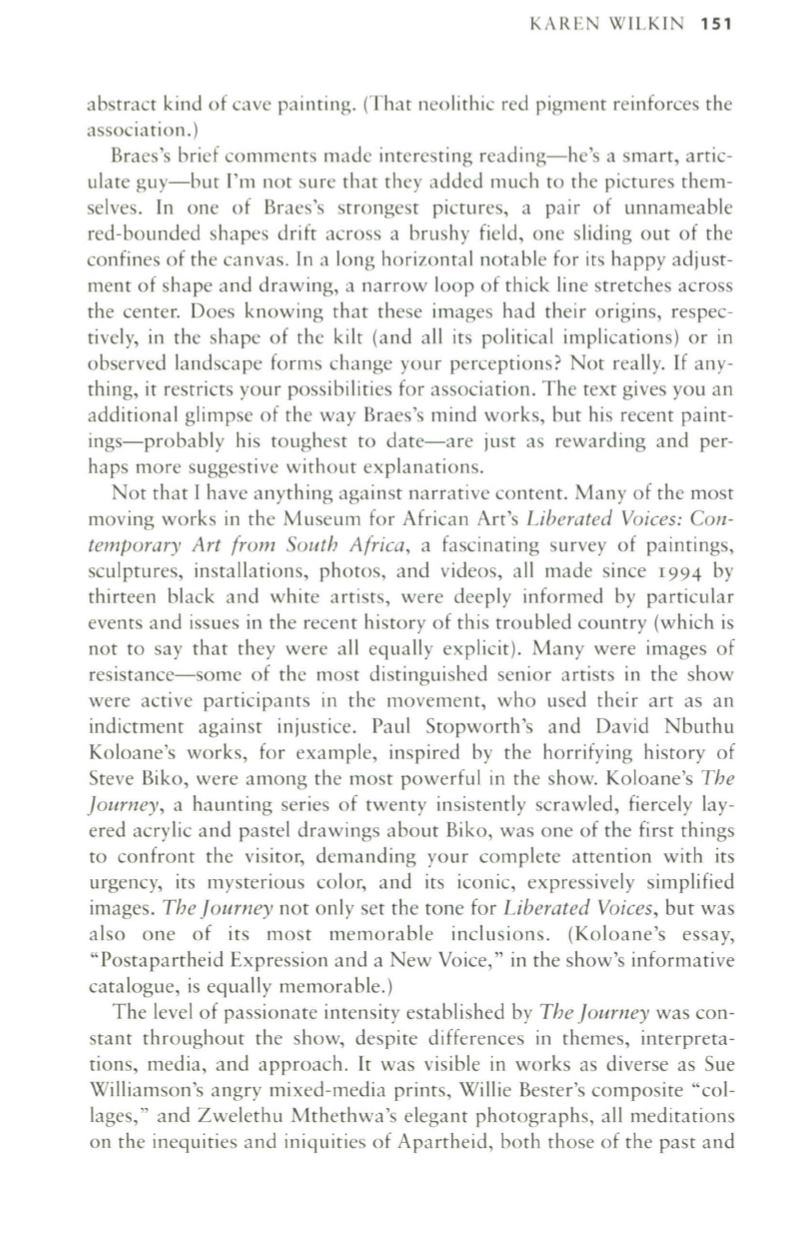
KAREN WILKIN
151
abstract kind of cave painting. (That neolithic red pigment reinforces the
association.)
Braes's brief comments made interesting reading-he's a smart, artic–
ulate guy-but I'm not sure that they added much to the pictures them–
selves. In one of Braes's strongest pictures, a pair of unnameable
red-bounded shapes drift across a brushy field, one sliding out of the
confines of the canvas. In a long horizontal notable for its happy adjust–
ment of shape and drawing, a narrow loop of thick line stretches across
the center. Does knowing that these images had their origins, respec–
tively, in the shape of the kilt (and all its political implications) or in
observed landscape forms change your perceptions? Not really.
If
any–
thing, it restricts your possibilities for association. The text gives you an
additional glimpse of the way Braes's mind works, but his recent paint–
ings-probably his toughest to date-are just as rewarding and per–
haps more suggestive without explanations.
Not that I have anything against narrative content. Many of the most
moving works in the Museum for African Art's
Liberated Voices: Con–
temporary Art from South Africa,
a fascinating survey of paintings,
sculptures, installations, photos, and videos, all made since 1994 by
thirteen black and white artists, were deeply informed by particular
events and issues in the recent history of this troubled country (which is
not to say that they were all equally explicit). Many were images of
resistance-some of the most distinguished senior artists in the show
were active participants in the movement, who used their art as an
indictment against injustice. Paul Stopworth's and David Nbuthu
Koloane's works, for example, inspired by the horrifying history of
Steve Biko, were among the most powerful in the show. Koloane's
The
Journey,
a haunting series of twenty insistently scrawled, fiercely lay–
ered acrylic and pastel drawings about Biko, was one of the first things
to confront the visitor, demanding your complete attention with its
urgency, its mysterious color, and its iconic, expressively simplified
images.
The Journey
not only set the tone for
Liberated Voices,
but was
also one of its most memorable inclusions. (Koloane's essay,
"Postapartheid Expression and a New Voice," in the show's informative
catalogue, is equally memorable.)
The level of passionate intensity established by
The Journey
was con–
stant throughout the show, despite differences in themes, interpreta–
tions, media, and approach. It was visible in works as diverse as Sue
Williamson's angry mixed-media prints, Willie Bester's composite "col–
lages," and Zwelethu Mthethwa's elegant photographs, all meditations
on the inequities and iniquities of Apartheid, both those of the past and


